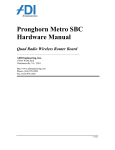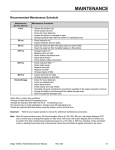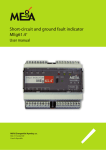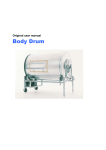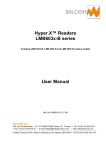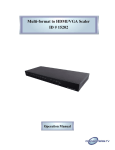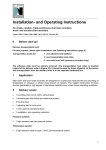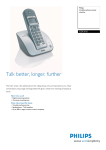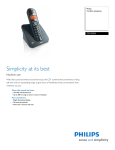Download ed210 gas detector - Electronic Devices
Transcript
E ED210 GAS DETECTOR POWER SENSOR 1 ALARM SENSOR 2 ALARM SENSOR 1 FAULT SENSOR 2 FAULT RESET ALARM ACCEPT GAS GAS ON GAS OFF MANUFACTURED BY ELECTRONIC DEVICES LTD. WORCESTER ENGLAND ED210 GAS DETECTOR INSTALLATION MANUAL Address: Enigma House, Enigma Business Park, Malvern, Worcestershire, WR14 1GD Tel: +44 (0)1684 891500 Fax: +44 (0)1684 891600 Email: [email protected] Website: www.electronic-devices.co.uk INDEX PAGE GENERAL SPECIFICATION FuNCTION DIAGRAM 3 CONNECTION LIST CONNECTION DIAGRAM 4 SUITABLE SENSORS DIMENSIONS DIAGRAM 5 INSTALLATION 6 OPERATION, TESTING AND CALIBRATION 7 ED210 IM REV 2 05.05.2015 ED210 - GAS DETECTOR 2 GENERAL IMPORTANT: DANGEROUS VOLTAGES ARE PRESENT WITIN THE 240V CONTROL UNIT. THE EQUIPMENT MUST NOT BE MODIFIED IN ANY WAY AND MUST BE INSTALLED AND SERVICED BY COMPETENT PERSONNEL ONLY. IF IN DOUBT CONSULT ELECTRONIC DEVICES LTD (01684) 891500 The ED210 Gas Detector is a fixed installation flammable gas detection system that will indicate gas concentrations well below the lower explosive limit (LEL) of most explosive gases. In addition, some toxic gases are detected, e.g. Carbon Monoxide, which is a valuable extra feature. For more information consult the list on Page 7 and in the sales leaflet. The ED210 is available for 12V D.C., 24V D.C. and 240V 50Hz operation. It is important that the correct model is chosen for the particular installation; this may be checked from the combined serial number/voltage supply label on the side of the Control Unit containing the cable entry grommets. Attention is drawn to the need for accurate calibration using a sample of the actual hazardous gas in a particular location (see Page 5). The Factory Inspectorate and Electronic Devices Ltd recommend that the procedure is carried out on first installation and regularly thereafter. The Operating Procedure explains how valuable indication of the service status of the equipment may be obtained by simple observation of the Control Unit indicators when switching on. To meet the statutory requirements. The equipment may be upgraded by fitting Explosion Proof Sensors (Exd). SPECIFICATION Power input 12VDC, 24VDC and 240VDC models available (Please advise on order) Typical current consumption in standby condition = mA Both zones in alarm condition = mA ED6 sounder = mA ENCLOSURE DIMENSIONS See diagram on page 5 FUNCTION DIAGRAM E MAIN POWER ED210 GAS DETECTOR POWER SENSOR 1 ALARM SENSOR 2 ALARM SENSOR 1 FAULT SENSOR 2 FAULT GAS SENSOR ALARM SENSOR FAULT ALARM ACCEPT Illuminates red when sensor in alarm condition Illuminates amber when sensor in fault condition. GAS ON RESET RESET Illuminates green when power input is active. Resets control panel and detectors. GAS OFF MANUFACTURED BY ELECTRONIC DEVICES LTD. WORCESTER ENGLAND ALARM ACCEPT Accepts alarms and silences sounders. GAS ON Operates connected solenoid valve. (EDL valve only). GAS OFF Deactivates connected solenoid valve. (EDL valve only). Note: EDL can supply a low consumption valve ED210- GAS DETECTOR 3 CONNECTIONS Connections to external field wiring are made via the PCB mounted terminals on the circuit board attached to the panel. Cable entry should be made via cable glands in the base of the enclosure. Terminal number Additional 240V ED210 Terminal Connections 1 +VE Valve drive N.B. Special 2 -VE 3/8” 12V / 24V Valve from EDL only 3 -VE External Audible 4 +VEAlarm 5 Brown Sensor 1 6 Green / Yellow 3-way terminal block 7 Blue 8 Brown Sensor 2 9 Green / Yellow 3-way terminal block 10 Blue 11 -VE supply I/P Supply input 12VDC or 24VDC 12 +VE supply I/P Supply input 13 C 14 NO 15 NC 16 L 17 N 18 E VR1 Use VR1 to adjust SENSOR 1 ALARM C - Volt Free Contact (If Fitted). NO NC Live 240VAC Mains Input (If Fitted). Neutral Earth Use VR2 to adjust SENSOR 2 ALARM VR2 Clockwise turn increases sensitivity to gas Clockwise turn increases sensitivity to gas Anti-clockwise turn decreases sensitivity to gas Anti-clockwise turn decreases sensitivity to gas + C NC NO VFC 1 2 3 4 5 6 7 8 9 10 11 12 ED210 - GAS DETECTOR WARNING! Ensure correct voltage before connecting 12VDC and 24VDC models available L N E MAINS I/P VOLT FREE CONTACTS AND MAINS I/P FOR 240V CONTROL PANEL 13 14 C NC VFC 15 16 NO L 17 18 N E MAINS I/P 4 SUITABLE SENSORS If either of the sensor connection terminals are not in use then the use of a 47K resistor between Brown/Green yellow terminals can be used to stop the unit displaying a fault. The ED210 is compatible with ‘type A’ sensors Non I.S EDP 1A EDP 2A EDP 3A I.S Flameproof sensors EDF 1A EDF 2A EDF3A DIMENSIONS E ED210 GAS DETECTOR POWER SENSOR 1 ALARM SENSOR 2 ALARM SENSOR 1 FAULT SENSOR 2 FAULT RESET ALARM ACCEPT GAS GAS ON GAS OFF MANUFACTURED BY ELECTRONIC DEVICES LTD. WORCESTER ENGLAND 235 mm ED210- GAS DETECTOR 5 INSTALLATION THE ED210 CONTROL PANEL The control panel should be mounted in a convenient position for the operator, away from possible mechanical damage or ingress of moisture, and allowing the front panel to swing for ease of calibration etc. The front panel is opened by releasing the blue catch on the right hand side of the transparent lid. The enclosure is secured to a wall or bulkhead by using the appropriate method detailed in the FIBOX leaflet enclosed. Sufficient clearance should be allowed for the cables to enter, via cable glands fitted in the bottom face, without undue kinking. Without external devices the normal maximum consumption is less than 1A so that power supply cable should, (a) have 1A current capacity minimum, and (b) not permit more than 0.25V drop along its length (12V or 24V DC versions). In practice, unless lengths greater than 50m are necessary then 15A current capability cable is suitable. The input voltage should be in the range 10.5 to 14V (12V) and 21.5 to 28V (24V). It is advisable to wire the gas detector via its own main switch so that it may become operational without having other electrical equipment energised. This enables a test for gas to be made without danger of explosion through spark ignition. An HBC 2A fuse (max.) should be fitted in the live lead of the mains version. SENSORS If Explosion Proof Sensors are to be fitted, then (a) only competent personnel should undertake the installation, and (b) the instructions supplied with the Sensors must be followed. The polypropylene Sensors normally supplied are mounted in the spring clips provided and a suitable length of cable should be easily detachable to allow for calibration. A connection junction box must be screwed to the wall so that it is impossible to disconnect them accidentally. The sensor should be mounted in the spring clip so that the ventilation holes are at the bottom and the cable is at the top of the Sensor case. Should damage occur due to the ingress of water or other foreign media, the Sensor must be replaced. SITTING The Sensor Heads should be placed lower than gas appliances when the gas to be detected is heavier than air. If the gas is lighter than air, then the Sensors should be placed above possible sources of gas leaks. Attention should be given to the probable gas flow in the particular installation concerned so as to site the Sensor in the most advantageous position. In sleeping or living quarters, particularly when heating appliances may consume oxygen, it may be advisable to mount one of the Sensors to detect Carbon Monoxide, i.e. just above floor level. AUDIBLE AND VISUAL ALARMS Terminals 3 and 4: The standard ED6 sounder/beacon consumes a minimum current and so the cable size is almost negligible. If more powerful Alarms are required, the maximum current that can be drawn is 0.5A for a 12/24V version. The Alarms are polarised so that connections should be as in the block diagram. The sound emitted from the ED6 may be varied (Please see the leaflet sent with the sounder). Remote Valve Terminals 1 and 2: Where a low-pressure valve is being connected directly to the Control Unit, check that the voltage marked on the side of the Valve is the same as that on the Control Unit. The Valve must be supported by the bracket provided. Ensure that the Valve is connected correctly into the pipe work; note that there is an inlet and an outlet clearly marked on the Valve and this must be observed. Also note that the Valve is a low pressure type, having a capability of controlling 1.5 PSI maximum, therefore it should be fitted after the standard Calor Gas regulator in the gas supply line. It is suitable for Butane and Propane LPG cylinders supplied by the Calor Gas Co Ltd, and others. IMPORTANT The valve coil and the control unit circuitry are matched electrically. Failure to use the valve supplied by Electronic Devices Ltd can cause misoperation and may be unsafe. If in doubt, consult Electronic Devices Ltd. ED210 - GAS DETECTOR 6 OPERATION & TESTING OPERATING INSTRUCTIONS When first switched on from cold the red warning lights should illuminate within a few seconds and then should remain on. After a few minutes depress the ‘Reset’ switch and the red lights should cancel. If they do not, then either there is gas around the Sensor Head, or the Unit is incorrectly wired. If this sequence is correct, then proceed as follows. If a gas valve is fitted, the gas valve may be energised using the following procedure: Operate the ‘Gas Enable’ switch by pressing the ‘Gas On’ switch momentarily. Gas should now be available. Note that the green gas light should illuminate when the ‘Gas Enable’ switch is operated. In the event of a gas leak, the Valve will be closed and the gas light will extinguish. When the gas has been cleared it will be necessary to depress the ‘Gas On’ switch again before gas will flow. The ‘Gas Enable’ switch is a convenient position at which to remotely operate the gas valve in normal circumstances. The ‘Gas Off’ switch turns the gas valve off. It may be necessary to ensure that all unlit burners on a gas stove, pilot lights, etc are switched off before turning the gas valve on. Under fault conditions, if the Valve is disconnected, then the gas light will extinguish. Whenever the gas warning light illuminates it will remain in that condition, thereby stopping gas from flowing etc., until both the gas has been cleared and the ‘Reset’ switch depressed. To avoid unnecessary Audible Alarms, the ‘Alarm Accept’ button should be pressed in the event of a warning and this will immediately stop the Audible Alarms, but will not allow the gas to flow. Faults are indicated by an internal audio alarm and the front panel sensor fault lights. IN SERVICE TESTING A full test of a gas detector must involve immersing the Sensors in an appropriate gas concentration and ensuring that the appropriate alarms operate. However, a quick test of Sensor wiring and Control Unit electronics may be made by momentarily connecting a 3.3Kohm resistor between the Brown and Green/Yellow leads in the side of the plug/socket assembly near the Sensor Head. This action simulates the Sensor reaction at approximately 25% LEL Butane, Propane, etc. If a Sensor fails to reset as indicated by the red lights being permanently illuminated, a quick test is to remove the Sensor wiring at the Control Unit or at the Sensor plug and socket assembly, and ensure that the red lights extinguish by depressing the ‘Reset’ switch. If this is the case, the problem is in the Sensor and not in the Control Unit. If the red lights remain on, the problem is in the Control Unit itself. Advice should then be sought from Electronic Devices Ltd. CALIBRATION Calibration must be performed on site after installation and therafter once every 12 months or sooner if necessary. Before despatch each gas sensor is approximately set to give the alarm at standard alarm levels for the gas concerned. Note that on site calibration is a requirement of the Factory Inspectorate! This calibration procedure should then be carried out at periodic intervals. The procedure is as follows: (i) Allow the sensors to warm up for at least one hour before attempting the calibration procedure. This is where the set has previously been in service for long periods. If the sensor has been out of commission for several weeks, then the sensor should be allowed at least 24 hours continuous operation before the calibration procedure is attempted. (ii) Open the front panel to allow easy access to the two small Blue and White potentiometers mounted on the printed circuit board. (iii) After the initial stabilisation period, outlined in (i) above, has been carried out, rotate the adjusting presets on the PCB fully anticlockwise and press the Reset switch so that the red warning lights cancel. If the lights do not cancel then a fault exists or gas is present; if the former, a competent technician or Electronic Devices Ltd must be consulted. (iv) Place each sensor into the gas concentration of the particular gas concerned and allow a few seconds for the gas to penetrate the sensor. Then slowly rotate the appropriate potentiometer clockwise until the appropriate red warning light just illuminates. Repeat this procedure for the next sensor. ED210- GAS DETECTOR 7 REACTION TO DIFFERENT GASES For guidance purposes only, we list below the approximate equivalent alarm level for other gases at the 0.5% Butane setting for a Type 1 Sensor. LEL in air (Vol 5%) Equivilent detection level Density in air (Air = 1) Butane 1.8 0.5 2.0 Propane 2.1 0.5 1.6 Acetylene 2.5 0.75 0.9 Ammonia 16.0 2.5 0.6 Hydrogen 4.0 0.04 0.07 Petrol Vapour 1.4 0.5 3.0 Carbon Monoxided 12.5 0.9 1.0 Gas CARBON MONOXIDE At the preset level of 25% LEL Propane the Sensors will respond to the presence of Carbon Monoxide well before 20% of its LEL. More serious, however, are the toxic effects of Carbon Monoxide on the human body summarized below: Vol. Pure CO in Air Symptoms 0.6% Headache, dizziness, nausea in 20 minutes. Death in 2 hours 0.32% Headache, etc. within 10 minutes. Death in 30 minutes 0.64% Headache, etc. within 2 minutes. Death in 15 minutes 1.28% Death in 3 minutes Sensitivity could be adjusted so that sensors will respond to 0.03% Carbon Monoxide in air. Such super sensitivity would mean, however, that they react to stray whiffs of cigarette smoke and other fumes causing incessant false alarms. At the present sensitivity our sensors will not respond until 1.0% Carbon Monoxide in air has accumulated. Even so they give valuable warning of any sudden appearance of Carbon Monoxide – especially via leaking exhaust systems because other hydrocarbons will be present. If Carbon Monoxide is thought to be a great danger in a particular situation then the sensitivity should be reset to a lower level. It is emphasized however that the sensor used is not particularly designed for the detection of Carbon Monoxide it is only a valuable additional feature. If Carbon Monoxide is an interfering gas we can supply a different sensor type that is less susceptible while maintaining excellent response to other gases. ED210 - GAS DETECTOR 8











